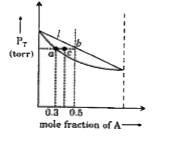Calculate the relative lowering in V.P. if 10 g of a solute (molar mass 100) are dissolved in 180g water.Solution in Malayalam
0.99
0.099
9.9
0.0099
The correct Answer is:D
P∘−PsP∘=nn+N=xB
nB=0.1,nA=10
xB=0.110.1=0.0099
Topper's Solved these Questions
- SOLUTIONSBOOK - BRILLIANT PUBLICATIONCHAPTER - SOLUTIONSEXERCISE - Level II
50 Videos
- SOLUTIONSBOOK - BRILLIANT PUBLICATIONCHAPTER - SOLUTIONSEXERCISE - Level II (Assertion & Reason Type)
20 Videos
- SOLUTIONSBOOK - BRILLIANT PUBLICATIONCHAPTER - SOLUTIONSEXERCISE - Level-III (Linked Comprehension Type)
12 Videos
- SOLID STATEBOOK - BRILLIANT PUBLICATIONCHAPTER - SOLID STATEEXERCISE - LEVEL-3 (Linked Comprehension Type)
10 Videos
- STEREOCHEMISTRY BOOK - BRILLIANT PUBLICATIONCHAPTER - STEREOCHEMISTRY EXERCISE - LEVEL-II (ASSERTION - REASON TYPE)
2 Videos
Similar Questions
The volumes of two HCl solutions A (0.5N) and B(0.1N) to be mixed for preparing 2 L of 0.2 NHCl are:
View SolutionAssertion : If a liquid solute more volatile than the solvent is added to the solvent, the papour pressure of the solution may increase i.e. ps>p∘.
Reason In the presence of a more volatile liquid solute, only the solute will form the vapours and solvent will not.
View Solution1 mole of A and 1 mole B are mixed together to form an ideal solution at 25∘C. Solution is placed in a vessel fitted with piston. If pressure on the solution is reduced isothermally.

Correct relationship between P∘AandP∘B is
View SolutionF centre is an example of metal excess defect due to the presence of extra cations at interstitial sites. Zinc oxide is white in colour at room temperature, on heating it loses oxygen and turns yellow.
ZnOHeat−−→Zn2++12O2+2e−
Now there is excess of zinc in the crystal and its formula becomes Zn1+x O. the excess of Zn2+ ions move to interstitial sites and the electrons to neighbouring interstitial sites.
There are many solids which are difficult to prepare in the stiochiometric composition and contain less amount of the metal as compared to stiochiometric proportion. a typical example of this type is FeO which is mostly found with a composition of Fe0.95. it may actually range from Fe0.96 O.
Q. In Fe0.95 O:
View SolutionAssertion : Meso tartaric acid is optically inactive
Reason : Meso tartaric acid has a plane of symmetry
View Solution10g of glucose (molar mass 180) and 20g of sucrose (molar mass 342) are dissolved in 100g of water. What will be the vapour pressure of the resultant solution if the vapour pressure of water is 30mmHg?
View SolutionA solution of sucrose (molar mass =342) is prepared by dissolving 688.4 g in 1000 g of water. Calculate
The boiling point of solution.
View SolutionA solution of sucrose (molar mass =342) is prepared by dissolving 688.4 g in 1000 g of water. Calculate
The freezing point of solution.
View Solution10gm of a solute is dissolved in 80gm of acctone V.P. of this sol=271mmofHg. If V.P. of acctone is 283mmofHg. Calculate molar mass of solute.
View SolutionCalculate the relative lowering in vapour pressure if 100 g of a nonvolatile solute.(mol.wt.100 ) are dissolved in 432 g watere.
View SolutionThe weight in grams of a non-volatile solute (molar mass = 60) to be dissolved in 90g of water to produce a relative of V.P. of 0.02 is
View SolutionA solution is prepared by dissolving 45g of sugar in 180g of water. Calculate the mass percentage of solute.
View Solution2.46 g of sodium hydroxide (molar mass = 40) are dissolved in water and the solution is made to 100 cm^(3) in a volumetric flask. Calculate the molarity of the solution
View SolutionSix grams of urea ( molar mass =60 ) are dissolved in 90 g of water. The relative lowering of vapour pressure is equal to
View Solution2.46 g of sodium hydroxide (molar mass = 40) are dissolved in water and the solution is made to 100cm3 in a volumetric flask. Calculate the molarity of the solution.
View Solution2.82g of glucose (Molar mass: 180g mol−1) are dissolved in 30g of water . Calculate mole fraction of glucose and water.
View Solution
